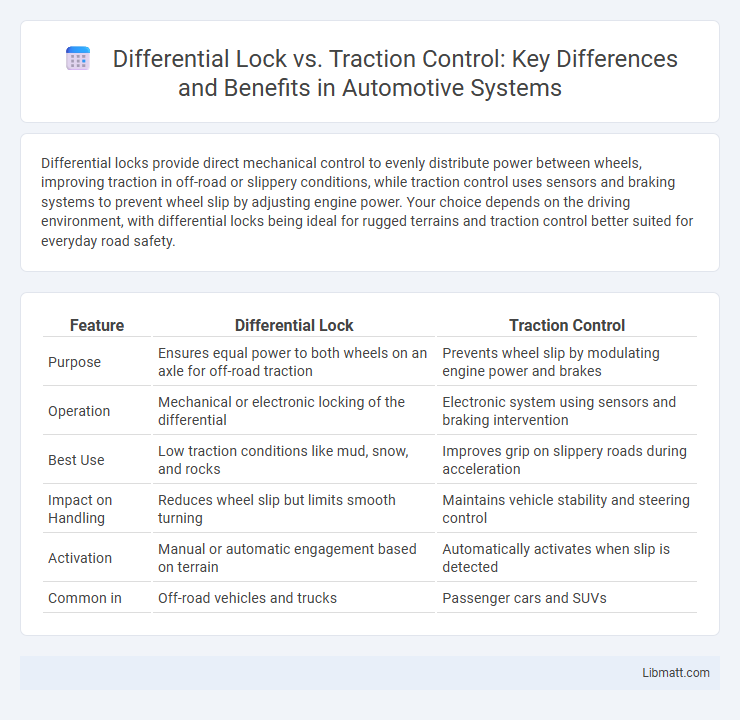Differential locks provide direct mechanical control to evenly distribute power between wheels, improving traction in off-road or slippery conditions, while traction control uses sensors and braking systems to prevent wheel slip by adjusting engine power. Your choice depends on the driving environment, with differential locks being ideal for rugged terrains and traction control better suited for everyday road safety.
Table of Comparison
| Feature | Differential Lock | Traction Control |
|---|---|---|
| Purpose | Ensures equal power to both wheels on an axle for off-road traction | Prevents wheel slip by modulating engine power and brakes |
| Operation | Mechanical or electronic locking of the differential | Electronic system using sensors and braking intervention |
| Best Use | Low traction conditions like mud, snow, and rocks | Improves grip on slippery roads during acceleration |
| Impact on Handling | Reduces wheel slip but limits smooth turning | Maintains vehicle stability and steering control |
| Activation | Manual or automatic engagement based on terrain | Automatically activates when slip is detected |
| Common in | Off-road vehicles and trucks | Passenger cars and SUVs |
Introduction to Differential Lock and Traction Control
Differential lock is a mechanical system that forces both wheels on an axle to rotate at the same speed, enhancing traction in off-road or slippery conditions by preventing wheel slip. Traction control is an electronic system that detects wheel spin and automatically applies brake force or reduces engine power to maintain grip and vehicle stability during acceleration. Both systems improve vehicle handling and safety but operate through different mechanisms tailored to specific driving environments.
How Differential Lock Works
A differential lock works by mechanically linking the wheels on the same axle, forcing them to rotate at the same speed regardless of traction differences. This system enhances vehicle stability and off-road performance by preventing wheel spin when one wheel loses grip, delivering power evenly to both wheels. Your vehicle benefits from improved traction in challenging terrain, such as mud, snow, or uneven surfaces, by ensuring consistent torque distribution.
How Traction Control Systems Operate
Traction control systems operate by continuously monitoring wheel speed sensors to detect slipping or loss of traction. When wheel slip is detected, the system automatically reduces engine power or applies braking force to specific wheels to restore grip. This enhances vehicle stability and control, especially on slippery or uneven surfaces, by preventing wheel spin without manual intervention.
Key Differences Between Differential Lock and Traction Control
Differential lock mechanically forces both wheels on an axle to rotate at the same speed, providing maximum traction in off-road or low-traction conditions. Traction control uses electronic sensors to detect wheel slip and selectively applies brake pressure or reduces engine power to maintain grip without locking the wheels. The differential lock offers a direct mechanical advantage for uneven terrain, while traction control ensures smoother, adaptive handling on varying surfaces.
Pros and Cons of Differential Lock
Differential lock improves traction by forcing both wheels on an axle to spin at the same speed, making it ideal for off-road or slippery conditions where wheel slippage occurs. However, it can cause increased tire wear and steering difficulties on hard surfaces due to the lack of difference in wheel speed during turns. Your vehicle benefits from enhanced control in challenging terrains but may suffer reduced maneuverability and increased mechanical stress on paved roads.
Pros and Cons of Traction Control
Traction control enhances vehicle stability by automatically reducing wheel slip during acceleration, improving safety on slippery or uneven surfaces. It can, however, limit off-road capability and reduce driving enjoyment for enthusiasts by intervening too aggressively in throttle and brake applications. While effective on paved and moderate off-road conditions, traction control systems may struggle in extreme off-road environments where manual control, such as using a differential lock, offers better performance.
Best Use Cases for Differential Lock
Differential locks are best used in off-road or low-traction conditions where wheel slip occurs frequently, such as mud, snow, or rocky terrain, providing maximum torque to both wheels on an axle. Traction control is more effective on paved roads or mild slippery conditions by selectively braking wheel spin to maintain stability without sacrificing maneuverability. Your vehicle benefits from engaging the differential lock in extreme environments to enhance grip, while traction control supports safe driving on less challenging surfaces.
Best Use Cases for Traction Control
Traction control excels in on-road driving conditions where maintaining grip on slippery surfaces like wet asphalt or ice is critical. It optimizes wheel spin by automatically adjusting engine power and braking individual wheels, enhancing stability and safety during acceleration. This system is ideal for everyday driving scenarios and light off-road terrain where smooth and controlled traction is necessary.
Off-Road Performance: Differential Lock vs Traction Control
Differential locks enhance off-road performance by mechanically forcing wheels to rotate at the same speed, ensuring maximum traction in challenging terrains like mud, rocks, or steep inclines. Traction control, on the other hand, uses electronic sensors to detect wheel slip and selectively apply brakes or reduce engine power, offering smoother handling on less extreme off-road conditions. Your choice depends on the level of terrain difficulty and whether you prioritize mechanical grip or electronic assistance for off-road driving.
Choosing the Right System for Your Vehicle
Selecting the ideal system for your vehicle depends on terrain and driving conditions, where differential locks provide superior control in extreme off-road situations by locking the axle to ensure equal power distribution. Traction control systems enhance stability and safety on slippery or paved roads by automatically modulating engine power and braking to prevent wheel spin. Evaluating your typical driving environment aids in determining whether the mechanical engagement of a differential lock or the electronic assistance of traction control best suits your vehicle's performance needs.
Differential Lock vs Traction Control Infographic

 libmatt.com
libmatt.com